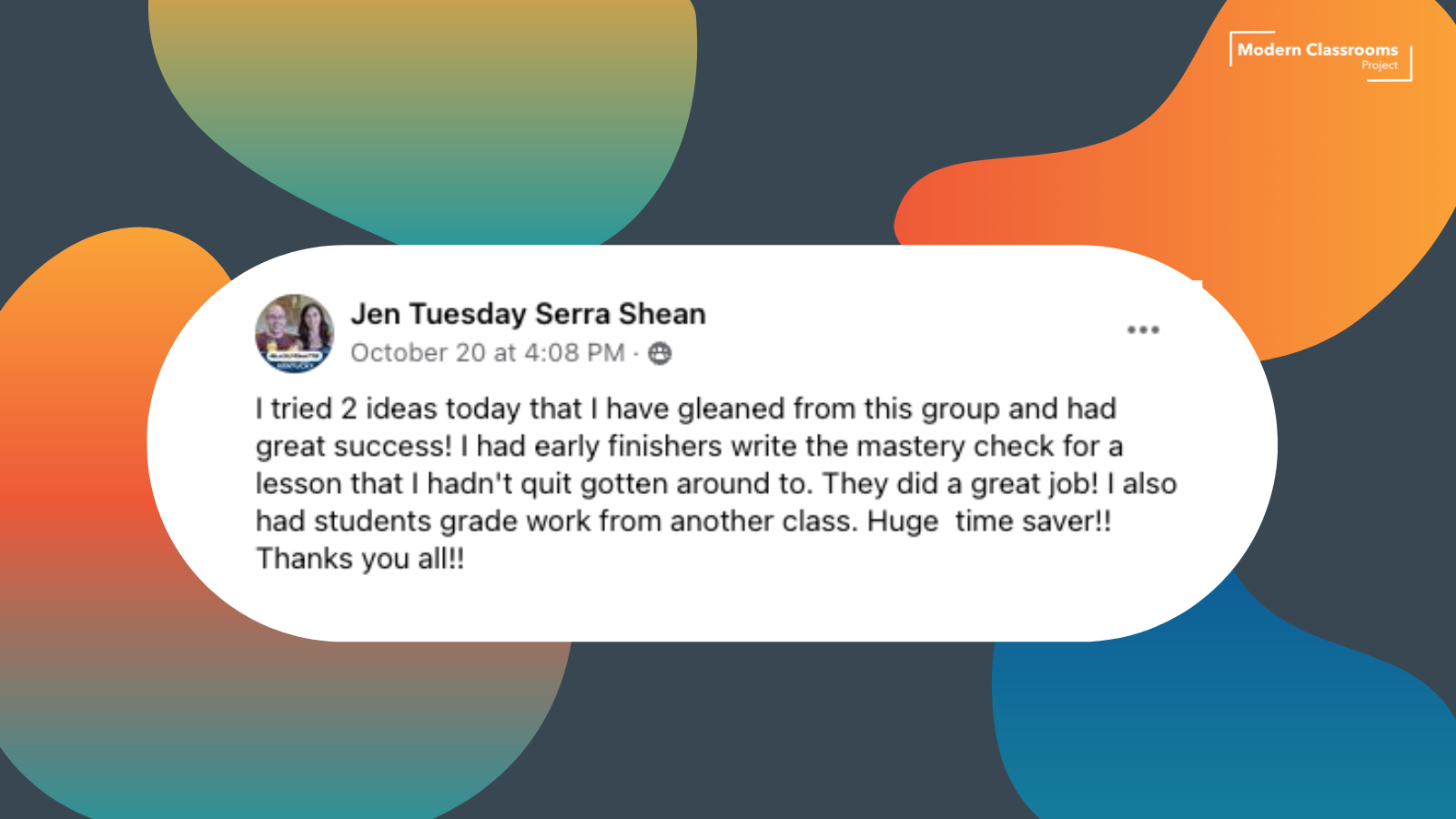3 Tips for Self-Pacing with Nontraditional Students
Welcome to the Modern Classrooms Project Podcast. Each week we bring you discussions with educators on how they use blended, self-paced, and mastery-based learning to better serve their students. In this episode, Toni Rose Deanon sat down with virtual school educator Brandy Netherton and innovation school educator Pierce Woodward to discuss their best practices for implementing a Modern Classroom with nontraditional students.
Nontraditional education - whether you’re teaching in atypical settings, educating exceptionally large class sizes, or groups of students dealing with challenges and circumstances outside of the norm - can be a lonely place to teach. We’ve collected best practices from two educators who teach in nontraditional settings.
Consider the Vibes
If your students consistently struggle to come to school or don’t find school to be a particularly safe place, making your classroom a soft place for them to land can make the difference. Pierce’s classroom mimics a coffee shop - “I’ve got a bunch of lamps in there and music going. I’ve got house plants,” he says. Finding ways to swap the stark lighting and classroom feel for a place students might be more comfortable can change the whole feeling of your classroom.
Additionally, making the space a reflection of your class by displaying student work can be another shortcut to changing the mood of your classroom. Pierce hangs student work throughout his room, even for his older students. The exemplars can be a point of pride for students and help others as they complete an assignment. But it doesn’t all have to be academic. “I have a whiteboard I call it my ‘Wow Board,’ where I kind of shout out students who are on pace or at a pace,” he says. In this way, he ensures that his classroom accurately reflects his students.
If you don’t have a physical space to make your own, you might consider how you can curate either your live or asynchronous virtual space. Brandy, who teaches at a virtual school, uses post-lesson surveys to not only keep track of student work, but to encourage student reflection and to learn more from them about what resonated and supported them best.
Make the Work Doable
For many students, school and failure are intricately connected. This can show up in the classroom as a lack of motivation. Sometimes the best way to motivate students is to help them find an entry point to the work. After all, once they get started, it’s so much easier to continue! For Pierce’s English Language Arts class, he uses audiobooks, sentence starters, and graphic organizers to provide easier points of connection for students. “Anything I can do to make it doable and kind of give them credit for these little things that they do and try to build up some wins before we start to dial up the rigor,” he says.
Brandy’s large classes of online students also struggle with motivation. “My biggest challenge is getting students to participate in the lessons because they're not graded,” she says. She has started providing students with bonus points for exams and labs (which are graded) to encourage participation. Additionally, revision plays a big role in her class, but she doesn’t let students revise until they have gone back and completed at least one lesson. This encourages them to access the information provided to increase their knowledge and their performance on exams.
Consider Communications
Because Brandy works in a non-traditional setting, communication with students often looks non-traditional, as well. “In in-person school you never would get a student's phone number and text them. But here they want us to actually give out our cell number so that students can have another avenue to reach us,” she says. Although this won’t work for all educators or school settings, it can be a great way for students to connect with their teachers immediately and in a way that is most comfortable for them. This can be labor-intensive, so Brandy shares how she texts more than 200 students at once through Google Voice.
Communication with students is only one piece of the puzzle. Don’t forget about involving caregivers, especially in atypical learning situations! “If a student is completing all of their lessons or majority of their lessons, I'll send occasional positive texts home,” Brandy says. She keeps track of student progress and guardian contact information in the same place to make this even easier.
While it can be difficult to find your professional learning network as a teacher in a nontraditional setting, Brandy and Pierce show how important it is to share best practices and learn from other educators.
If you are still searching for a community of educators to work and learn with during your Modern Classrooms journey, we recommend joining our Facebook group of more than 10,000 educators.
Our Guests
Pierce Woodward
Brandy Netherton
Our Host
Toni Rose (she/her) strives to be the teacher that she never had growing up. She knew that she always wanted to be a teacher when she was little, and because of her love for reading and writing and struggles of learning English as a Filipinx immigrant, she became an English teacher. Toni Rose focuses on anti-racist, anti-bias work and wants to create a safe space for everyone around her. She especially loves being a thought partner for teachers. Toni Rose has taught in Atlanta, Baltimore City, DC, and currently resides in Washington state.
If you like what you hear in this episode, share it with a friend or subscribe to get updates when new podcasts are published.








